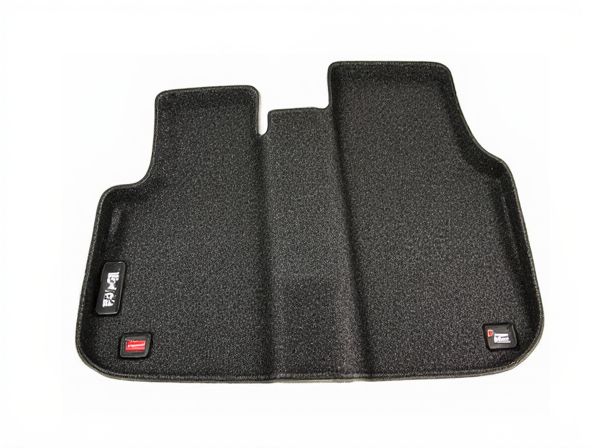
Photo illustration: Nylon Fiber vs Polypropylene Fiber
Nylon fiber offers superior strength, elasticity, and abrasion resistance, making it ideal for applications requiring durability and flexibility. Polypropylene fiber excels in moisture resistance, chemical stability, and lightweight properties, often used where water repellency and cost efficiency are priorities. When choosing fiber for your project, consider the specific performance needs and environmental conditions to ensure optimal material selection.
Table of Comparison
| Feature | Nylon Fiber | Polypropylene Fiber |
|---|---|---|
| Durability | High resistance to wear and abrasion | Moderate resistance to wear, less durable |
| Water Resistance | Moderate, absorbs some moisture | Excellent, highly water-resistant |
| Stain Resistance | Good, but can absorb stains | Superior, resists most stains easily |
| UV Resistance | Good, resists fading | Moderate, may fade over time |
| Comfort | Softer and more flexible | Less soft, firmer texture |
| Cost | Higher price point | More affordable |
| Environmental Impact | Less eco-friendly, synthetic production | Lower environmental impact, recyclable |
Introduction to Synthetic Fibers
Nylon fiber and polypropylene fiber are prominent types of synthetic fibers widely used in textiles and industrial applications. Nylon, known for its high tensile strength and elasticity, offers excellent abrasion resistance and resilience, making it ideal for durable fabrics and engineered composites. Polypropylene fiber provides exceptional chemical resistance and low moisture absorption, resulting in lightweight, quick-drying materials often utilized in geotextiles, upholstery, and filtration products.
Chemical Structure: Nylon vs Polypropylene
Nylon fibers consist of polyamides characterized by repeating amide linkages (-CONH-) in their backbone, providing strong hydrogen bonding, excellent durability, and resistance to abrasion. Polypropylene fibers are made from a hydrocarbon polymer with a simple, non-polar, and highly crystalline polypropylene chain (-CH2-CH(CH3)-), resulting in lightweight fibers with high chemical resistance but lower moisture absorption. The chemical structure differences directly influence their respective physical properties, affecting applications in textiles, industrial uses, and chemical environments.
Manufacturing Process Comparison
Nylon fiber is produced through a polymerization process involving caprolactam or hexamethylene diamine with adipic acid, followed by melt spinning and drawing to align molecular chains, resulting in high tensile strength and elasticity. Polypropylene fiber manufacturing uses a polymerization of propylene monomers, typically through a gas phase or solution polymerization process, and is extruded via melt spinning with less energy consumption than nylon, producing fibers with excellent chemical resistance and low moisture absorption. The differences in polymer chemistry and processing temperatures directly impact the fibers' mechanical properties, durability, and application suitability in textiles and industrial products.
Mechanical Properties and Strength
Nylon fiber exhibits higher tensile strength and superior elasticity compared to polypropylene fiber, making it ideal for applications requiring durability and flexibility. Polypropylene fiber offers excellent resistance to fatigue and chemical exposure but has lower tensile strength and elongation at break. The mechanical properties of nylon enable better abrasion resistance and impact absorption, whereas polypropylene excels in lightweight and moisture-resistant uses.
Durability and Wear Resistance
Nylon fiber exhibits superior durability and wear resistance compared to polypropylene fiber due to its higher tensile strength and elasticity, making it ideal for heavy-duty applications. Polypropylene fiber offers excellent resistance to chemical degradation and moisture but is less abrasion-resistant, leading to quicker wear under mechanical stress. Nylon's robust molecular structure and resistance to impact and fatigue significantly extend the lifespan of products under continuous use.
Moisture Absorption and Water Resistance
Nylon fiber exhibits high moisture absorption, typically absorbing up to 4-5% of its weight, which can lead to decreased strength and longer drying times. Polypropylene fiber, on the other hand, has extremely low moisture absorption, less than 0.01%, making it highly water-resistant and ideal for applications requiring quick drying and minimal water retention. This stark contrast in water resistance makes polypropylene preferable for moisture-prone environments, while nylon offers better comfort in wear due to its moisture-wicking properties.
Thermal Stability and Heat Resistance
Nylon fiber exhibits superior thermal stability with a melting point around 220degC, making it suitable for applications requiring moderate heat resistance. Polypropylene fiber, on the other hand, has a lower melting point approximately 160degC, limiting its use in high-temperature environments. The higher thermal stability of nylon enhances its durability under heat stress compared to polypropylene.
Common Applications in Industry
Nylon fiber is extensively used in the textile industry for manufacturing apparel, upholstery, and industrial fabrics due to its strength, elasticity, and abrasion resistance. Polypropylene fiber finds widespread application in geotextiles, filtration systems, and automotive parts because of its chemical resistance, lightweight nature, and moisture-wicking properties. Both fibers serve critical roles in construction, with nylon enhancing concrete reinforcement and polypropylene improving durability in cementitious composites.
Environmental Impact and Recyclability
Nylon fiber, derived from petroleum, has a higher environmental footprint due to energy-intensive production and slow biodegradability, but it offers better recyclability through mechanical and chemical processes. Polypropylene fiber, also petroleum-based, features lower production emissions and is highly resistant to degradation, which poses challenges for biodegradability yet allows straightforward mechanical recycling. Both fibers contribute to microplastic pollution; however, polypropylene's lighter weight and chemical resistance reduce transportation emissions and enable longer product lifespans, affecting overall environmental impact and recyclability potential.
Cost Analysis and Market Trends
Nylon fiber generally exhibits higher production costs compared to polypropylene fiber due to its complex manufacturing process and raw material prices, impacting its market pricing. Polypropylene fiber's cost-effectiveness and lightweight properties have driven significant growth in industries like packaging, automotive, and geotextiles, creating expanding market demand. Emerging trends indicate increased adoption of polypropylene in sustainable products, while nylon remains preferred in applications requiring superior durability and elasticity despite its premium cost.
 caratoz.com
caratoz.com